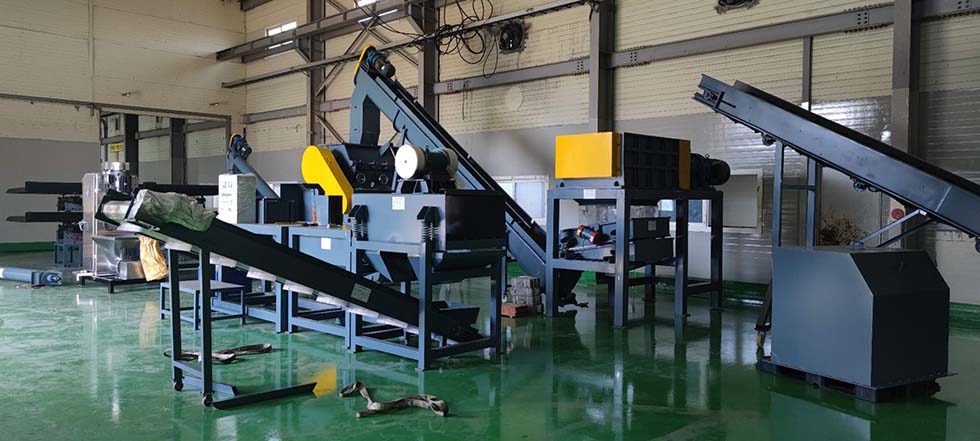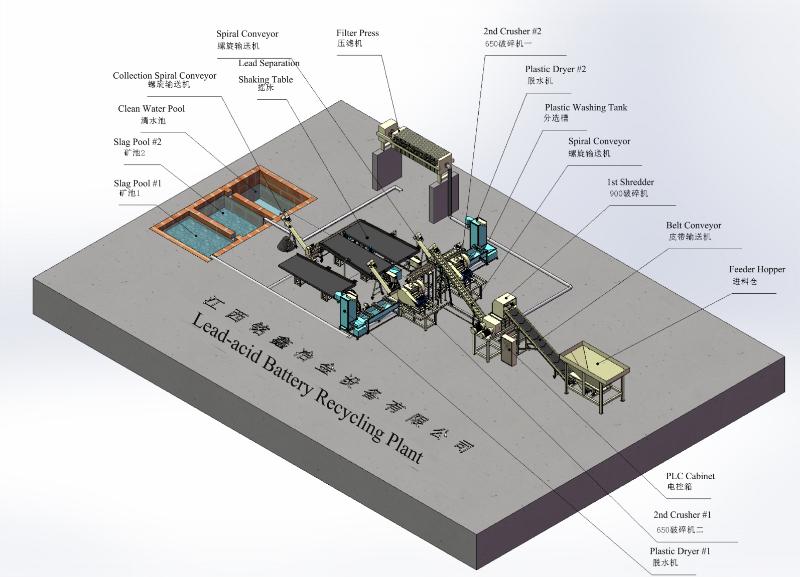
The battery recycling plant uses a proprietary mechanized process to effectively separate lead and plastic components from lead-acid batteries. The purity of lead produced by this process is 97%. This environmentally friendly approach is a more sustainable alternative to traditional pollution-based methods such as combustion and chemical treatment.
The battery recycling plant consists of a series of mechanical equipment such as lead-acid battery cutting machines, shredders, vibrating screens, conveyors, granulators, sinks, hoppers, screw conveyors, gravity separation tables (shaking/vibrating screen tables), which together facilitate the recycling process from the import of waste batteries to the production of recycled lead.
Our company has developed an innovative waste lead-acid battery recycling system using a range of cutting-edge technologies. The process begins with the breaking and separation of the lead battery, followed by the separation of acid, lead paste, lead grid and plastic. The batteries are fed into the shredder on a conveyor belt and then through a pelletizer and hydraulic sorting system. This allows the separation and pasting of plastic and lead mesh based on their density. The electrolyte, or waste acid, in the battery is then picked up and recycled in the waste acid treatment system.

Parameters of lead-acid battery recycling plant
| Options |
Technical standard |
| ability | 0.5 to 5 tons per hour |
| Overall scale | 25*5*7 meters |
| Lead recovery | 96% |
| Plastic recovery rate | 98% |
| Lead purity | 99% |
| Options | |
|
1. The standard model body is made of durable steel, stainless steel is optional.
2. OEM production, the whole machine can be produced according to different sizes of batteries.
3. Warranty 12 months, a set of wearing parts random free delivery.
4. Battery case cleaning and crushing system and crushing system are optional.
|
|
Process flow of lead-acid battery recycling plant
Step 1. The battery transported by belt conveyor is initially crushed (900×1050 4-axis crusher), and the crushed lead particles, plastic particles and lead mud are sorted by the vibrating screen at the bottom of the crusher in the first step to separate a part of the lead mud.
Step 2. The particles after passing through the first crusher are transported to the second crusher for smaller particles by a screw conveyor.
Step 3. After the second crushing, the particles will go into the sink, where the light plastic will be sorted. Heavy lead particles and heavy plastics sink to the bottom of the tank and are transported by screw conveyors to the sorting equipment for sorting.
Step 4. Finally, the difference of specific gravity between plastic and lead particles is used to separate the two materials with a shaking table to obtain lead particles and plastic particles without impurities. Lead particles can be made into lead ingot by smelting furnace, while plastic particles can be reused.
Step five. In the crushing and sorting process, the lead mud needs to be separated from water by a filter press, and then melted together with lead particles to obtain lead ingots
After you get the lead pellets, you can sell them to a smelting company, or you can set up a smelting plant yourself, we also provide advanced rotary and refining furnaces, the relevant case pictures are below.

 Waste lead-acid battery recycling plant-Solution-Jiangxi Mingxin Metallurgical Equipment Co., Ltd.
Waste lead-acid battery recycling plant-Solution-Jiangxi Mingxin Metallurgical Equipment Co., Ltd.